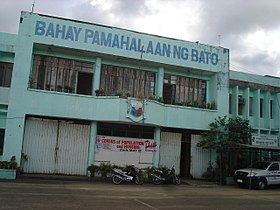Bato, Catanduanes
Appearance
| Bato | |
|---|---|
| Baley na Filipinas | |
 | |
 Lokasyon na Bato | |
 | |
| 13°36′0″N 124°18′0″E | |
| Dalin | Filipinas |
| Angipaletnegan | 1799 |
| Barangay | 27 |
| Kaawang | |
| • Katiponan | 48.62 km2 (18.77 sq mi) |
| Elebasyon | 156 m (512 ft) |
| Bilang na too (Mayo 1, 2020)[1] | |
| • Katiponan | 21,748 |
| • Densidad | 450/km2 (1,200/sq mi) |
| Economia | |
| • Clase | kumalima ya klase ya baley |
| • Ingresos | ₱91,988,498.49 (2020) |
| • Activos | ₱174,157,078.11 (2020) |
| • Pasivos | ₱52,875,433.24 (2020) |
| • Gastos | ₱77,028,004.79 (2020) |
| Kodigo na postal | 4801 |
| Kodigo na lugar | 52 |
| Website |
www |
Say Bato et kumalima ya klase ya baley ed luyag na Catanduanes, Filipinas. Unong ed 1 Mayo 2020 census, say populasyon to et 21,748 totoo tan 5,044 abong. Walay kabaleg tan sukat to ya 48.62 sq. km. Say zip code to et 4801.
Saray barangay
[dumaen | dumaen so pinanlapuan]- Aroyao Pequeño
- Bagumbayan
- Banawang
- Batalay
- Binanwahan
- Bote
- Buenavista
- Cabugao
- Cagraray
- Carorian
- Guinobatan
- Libjo
- Marinawa
- Mintay
- Oguis
- Pananaogan
- Libod Poblacion
- San Andres
- San Pedro
- San Roque
- Santa Isabel
- Sibacungan
- Sipi
- Talisay
- Tamburan
- Tilis
- Ilawod (Poblacion) 1
Demograpiko
[dumaen | dumaen so pinanlapuan]| Taon | Pop. | ±% p.a. |
|---|---|---|
| 1903 | 8,438 | — |
| 1918 | 12,888 | +2.86% |
| 1939 | 17,230 | +1.39% |
| 1948 | 18,716 | +0.92% |
| 1960 | 13,339 | −2.78% |
| 1970 | 13,948 | +0.45% |
| 1975 | 15,415 | +2.03% |
| 1980 | 15,099 | −0.41% |
| 1990 | 15,331 | +0.15% |
| 1995 | 16,535 | +1.43% |
| 2000 | 17,761 | +1.55% |
| 2007 | 18,738 | +0.74% |
| 2010 | 19,984 | +2.37% |
| 2015 | 21,279 | +1.20% |
| 2020 | 21,748 | +0.43% |
| Reperensiya: Philippine Statistics Authority[2][3][4] | ||
Saray reperensiya
[dumaen | dumaen so pinanlapuan]- ↑ "2020 Census of Population and Housing (2020 CPH) Population Counts Declared Official by the President". Hulyo 7, 2021. https://psa.gov.ph/content/2020-census-population-and-housing-2020-cph-population-counts-declared-official-president.
- ↑ Census of Population (2015). "Region V (Bicol Region)". Total Population by Province, City, Municipality and Barangay. PSA. Retrieved 29 June 2016.
- ↑ Census of Population and Housing (2010). "Region V (Bicol Region)". Total Population by Province, City, Municipality and Barangay. NSO. Retrieved 29 June 2016.
- ↑ Censuses of Population (1903–2007). "Region V (Bicol Region)". Table 1. Population Enumerated in Various Censuses by Province/Highly Urbanized City: 1903 to 2007. NSO.
